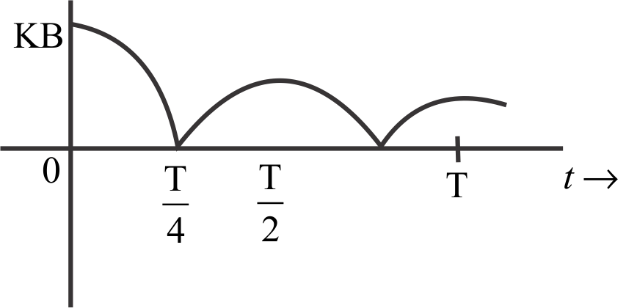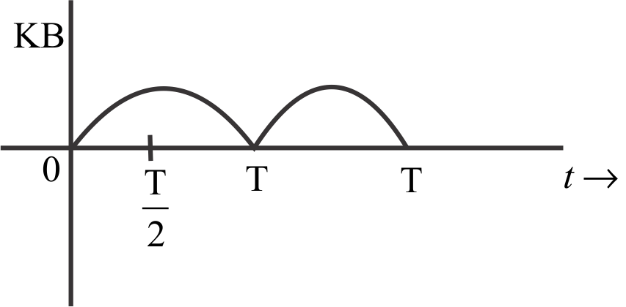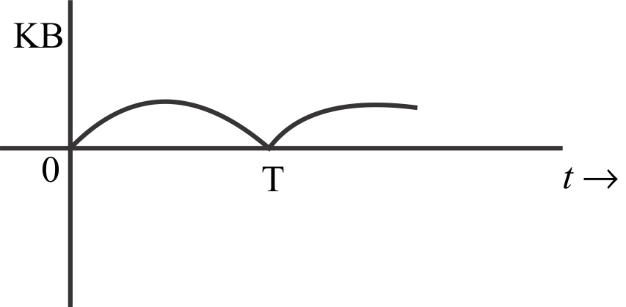
A particle is executing simple harmonic motion with a time period $T$. At the time $t = 0$, it is at its position of equilibrium. The kinetic energy-time graph of the particle will look like:
$\left( a \right)$

$\left( b \right)$

$\left( c \right)$

$\left( d \right)$

Answer
217.5k+ views
Hint: We have been given a particle having a simple harmonic motion about its equilibrium position. And we know whenever a particle performs the simple harmonic motion, it varies with time. And velocity at the mean position will be maximum. By using all this information we can answer this question.
Complete Step By Step Solution:
After executing the simple harmonic motion, the position of the particle will be
So it can be represented as -
$x = A\sin \omega t$
Now the velocity function can be represented by,
Velocity function is $v = \dfrac{{dx}}{{dt}}$
Since,
$v = A\omega \cos \omega t$
Kinetic energy, K.E. will be written as
$K.E = \dfrac{1}{2}m{v^2}$
On substituting the values of the velocity, we get
$ \Rightarrow \dfrac{1}{2}m{A^2}{\omega ^2}{\cos ^2}\omega t$
From this, we can say that the kinetic energy will be directly proportional to the ${\cos ^2}\omega t$
Mathematically, it can be written as
$ \Rightarrow K.E \propto {\cos ^2}\omega t$
But at $t = \dfrac{T}{4}$
The value of the angle will be
$ \Rightarrow \cos \left( {\omega \dfrac{r}{4}} \right) = 0$
Therefore by putting the values, we get the kinetic energy will be equal to zero.
Mathematically, it can be written as
$ \Rightarrow K.E = 0$
Now we will check at $t = \dfrac{T}{2}$
The value of the angle will be
$ \Rightarrow \cos \left( {\omega \dfrac{r}{2}} \right) = - 1$
Therefore by putting the values, we get the kinetic energy will be positive and hence kinetic energy will be maximum.
Now we will check it$t = T$, we get
The value of the angle will be
$\cos \left( {\omega T} \right) = 1$
Therefore by putting the values, we get the kinetic energy will be positive and hence kinetic energy will be maximum
So from all the equations we had got the options $A$ to match all the criteria.
Note: When harmonic motion occurs harmonic functions are the waveforms of the motions that result. In other cases, for example, various musical instruments, when the player stimulates the instrument in a certain way, multiple wavelengths of response are being stimulated at the same time. In that case, the waveform produced will be a combination of different frequencies.
Complete Step By Step Solution:
After executing the simple harmonic motion, the position of the particle will be
So it can be represented as -
$x = A\sin \omega t$
Now the velocity function can be represented by,
Velocity function is $v = \dfrac{{dx}}{{dt}}$
Since,
$v = A\omega \cos \omega t$
Kinetic energy, K.E. will be written as
$K.E = \dfrac{1}{2}m{v^2}$
On substituting the values of the velocity, we get
$ \Rightarrow \dfrac{1}{2}m{A^2}{\omega ^2}{\cos ^2}\omega t$
From this, we can say that the kinetic energy will be directly proportional to the ${\cos ^2}\omega t$
Mathematically, it can be written as
$ \Rightarrow K.E \propto {\cos ^2}\omega t$
But at $t = \dfrac{T}{4}$
The value of the angle will be
$ \Rightarrow \cos \left( {\omega \dfrac{r}{4}} \right) = 0$
Therefore by putting the values, we get the kinetic energy will be equal to zero.
Mathematically, it can be written as
$ \Rightarrow K.E = 0$
Now we will check at $t = \dfrac{T}{2}$
The value of the angle will be
$ \Rightarrow \cos \left( {\omega \dfrac{r}{2}} \right) = - 1$
Therefore by putting the values, we get the kinetic energy will be positive and hence kinetic energy will be maximum.
Now we will check it$t = T$, we get
The value of the angle will be
$\cos \left( {\omega T} \right) = 1$
Therefore by putting the values, we get the kinetic energy will be positive and hence kinetic energy will be maximum
So from all the equations we had got the options $A$ to match all the criteria.
Note: When harmonic motion occurs harmonic functions are the waveforms of the motions that result. In other cases, for example, various musical instruments, when the player stimulates the instrument in a certain way, multiple wavelengths of response are being stimulated at the same time. In that case, the waveform produced will be a combination of different frequencies.
Recently Updated Pages
Elastic Collision in Two Dimensions Explained Simply

Elastic Collisions in One Dimension Explained

Electric Field Due to a Uniformly Charged Ring Explained

Electric Field of Infinite Line Charge and Cylinders Explained

Electric Flux and Area Vector Explained Simply

Electric Field of a Charged Spherical Shell Explained

Trending doubts
JEE Main 2026: Application Form Open, Exam Dates, Syllabus, Eligibility & Question Papers

Derivation of Equation of Trajectory Explained for Students

Hybridisation in Chemistry – Concept, Types & Applications

Understanding the Angle of Deviation in a Prism

Understanding Collisions: Types and Examples for Students

How to Convert a Galvanometer into an Ammeter or Voltmeter

Other Pages
JEE Advanced Marks vs Ranks 2025: Understanding Category-wise Qualifying Marks and Previous Year Cut-offs

Units And Measurements Class 11 Physics Chapter 1 CBSE Notes - 2025-26

NCERT Solutions For Class 11 Physics Chapter 8 Mechanical Properties Of Solids

Motion in a Straight Line Class 11 Physics Chapter 2 CBSE Notes - 2025-26

NCERT Solutions for Class 11 Physics Chapter 7 Gravitation 2025-26

Understanding Atomic Structure for Beginners




